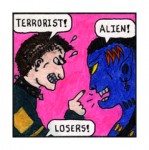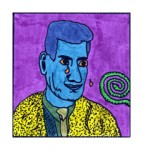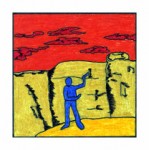 This one’s for Liephus.
This one’s for Liephus.
Preliminary Note:
I went to see this flick on a matinee and all I can say is dang! $7.50, plus $3.50 “3D charge”? That was 22 bucks for K and I. Talk about fleecing the customer. The theater was about 80% full, which isn’t bad for a Sunday afternoon and six weeks into the release.
As a result of the high prices, I saw very few people buying concessions—way to keep the theaters in business Hollywood! K and I smuggled in a water bottle and crackers. May both the theaters and Hollywood burn in the fires of Eblis Tech.
K knew this already, but I was very surprised to learn that you don’t necessarily get new 3D glasses when you see the movie. We both got used pairs. Luckily, K brought antiseptic wipes and we cleaned our allotted pair. Sure hope the person before me didn’t have a cold or worse!
Okay, okay, recycling. I get it. But what if I wanted a souvenir? What if I wanted to bring my pair back to another showing, in case the movie was so awesome I had to see it again? I don’t care about the “3D charge” always being tacked on, but if I pay I want to keep the glasses. Let me decide if I want to give them back for re-use.
They were obviously used too. The lenses were scratched and blotchy around the edges. But the worst indignity is that the glasses have anti-theft devices in the plastic, so you look like a moron if you try to remove them from the theater. Dude, I’m renting somebody else’s glasses?
So at the end of the film I stomped mine into several pieces and kicked them across the floor. Childish, I know. But it ticked me off. Way to make me feel positive about the 3D experience Hollywood!
Technical Analysis:
Okay, so the big selling point of the film is the visual effects. What else has Hollywood got these days? Certainly nothing remotely near a good yarn, that’s for sure. I’d say my visual experience was a mixed bag.
When the 3D visuals work, they work beautifully. The depth and disassociation of immersion are really something. I believed I was seeing another world and I felt myself plunging in.
Unfortunately, one thing 3D does not do well is breaking the screen barrier. When it happens, it throws you out of the movie and you have to start over.
For example, I’d be rushing through a forest with the main characters and then a fern frond or an insect would move too far out of frame and towards the audience in an awkward way, reminding me that this is just a movie with fancy tricks to distract you from looking too closely at the story.
Quite frankly if this is as good as it gets after 170 years of the technology (Stereoscopy was invented in 1840!) then these limits will never be surpassed. Regardless of high definition or whatever super realistic photo-realism you throw at the audience. It’s an illusion of depth, not actual depth.
One must always remember that the main vehicle of immersion is the audience members themselves—we fill in the blanks psychologically and naturally. But when the line is crossed the spell is broken. I just didn’t feel this medium has been mastered enough to make a push for 3D being the savior of the movie industry.
It’s hard to judge the computer-generated effects, particularly the giant blue cat people. Again, it’s a mixed bag. The 3D effect masks a lot of problems that might be more glaring in a non-3D version. I couldn’t help but be drawn in by the action of the characters and forget they were just advanced polygon conglomerations. But during slower scenes the characters at times seemed off to me.
Mainly I found my eyes growing tired two-thirds of the way into the movie and I just stopped noticing the 3D effect because I didn’t care anymore. About that time my eyes also started to water a lot, which made me chuckle. I wonder if those next to me were wondering why I was crying when the “super evil no doubt about it he deserves to die” bad guy finally was killed!
My thought is that the 3D did best when the movie was in nature mode—the National Geographic style exposition scenes really stood out. The computer graphics worked best when there was lots of action, but not so well when characters were hanging around talking.
The Meat And Potatoes:
It’s an average movie, made remarkable by the fact that:
- The dying movie industry has been churning out mostly poor material for a while, and
- It relies on the “event” gimmick of 3-D, reminiscent of carnival attraction psychology.
There’s precious little that’s new or groundbreaking in the movie. The world of the humans is pretty much cribbed from the dark realism of the Alien/Aliens/Outland vein. The world of the giant blue cat people is spectacular to behold, but we’re never allowed to immerse ourselves in it for long. The movie has an agenda (save the planet) and nothing is going to get in its way.
I seriously expected Michael Jackson to step out of a trapdoor and stand in front of the huge bulldozer plowing down the magic trees.
Which is funny, because if this were a real science fiction film, it would focus on the “shock” of the premise—humans becoming aliens to infiltrate and weaken them in order to exploit their world. What we get instead is fantasy, specifically the tried and true romance melodrama of the wounded hero who suffers indignity so he can inflict revenge on the source of his pain. It’s all about the sensationalism.
The criticisms of the film I’ve read focus on the characters and setting as if they were literally real. Watching the film, I couldn’t help but think it’s a case of most people being unable to distinguish between psychic, non-real facts and non-psychic, real facts.
To say that this movie is Dances With Wolves meets The Battle For Endor, or another story of “white hunter saves noble savages” misses the point entirely. It only scratches the surface.
I mean, there’s nothing plausible about this movie at all. It all takes place in the unconscious on a symbolic level. Any relation to the real world is only in the most superficial way.
You have human reason using the psychological constructs of cloned surrogates, mechanical exoskeletons and various forms of missile-firing VTOLs to invade the primordial unconscious.
The giant blue cat people aren’t people at all. They’re superhuman beings that exist in the unconscious. One has only to watch them walk through the neon glows of their environment populated by chimerical amalgamations of real animals and realize one is viewing numinous material.
In the unconscious all beings are by nature linked by the collective. It is the cloned surrogates, the avatars that allow humans to become hybrids and cross over into the unconscious.
What’s most disappointing to me is that this movie doesn’t depict any raise in consciousness at all. Ordinary people get to live back home on a “dead world” (the real world), while the big decisions get to be made by corporate and military officers, with scientists in the background as advisers as long as they say the right things.
But it’s all hopeless. The unconscious always wins in the end and human reason is annihilated—sent back to earth as POWs while the giant blue cat people get to continue living in the paradise of unconsciousness.
The movie begins with the main character watching his twin brother incinerated—a scientist representing the highest form of reason and the main character’s own connection to humanity—and ends with him abandoning his real body for a regression into the unconsciousness of infantile existence. It’s a bleak statement on the human condition that is safe, boring, and done to death by better movies with a fraction of this movie’s budget.
In a metaphorical sense the movie is not too far from the truth. The designated carriers of our own worst qualities are pressing dangerously into unknown territories from which tremendous natural forces might be unleashed to tragic effect.
Environmental catastrophe is a real danger, as is our running out of hydrocarbons with which to fuel our unchecked advance into the farthest reaches of outer space—so we can avoid inner space. But the movie never engages with these issues at all.
“Unobtainium” (the goal of the “bad guys”) is a good term—it doesn’t exist and it never existed. The whole military industrial complex is headed for a brick wall and all of us will be paying the price in work not done on ourselves.
The magicians of aboriginal populations have been using avatars for millennia. They at least have the good sense to come back and use what they have learned to help real people. Nope, not this movie. Our hero is on a one-way ticket to the faerie realms.
The people back home have no clue what just happened. The soldiers, suits and scientists haven’t learned squat. The fortunate few who have “gone native” and fight for the giant blue cat people all die. The giant blue cat people are embittered by their experiences and now hostile. The main character abandons his real life body for a supernatural one—just like when one becomes a vampire!
The modern savior as embodied by the hybrid is discarded. Nobody wins.
But if you are looking for an action flick that sells a vision of the powerless rising up to defeat their oppressors—psst, hey kid, rent these plastic glasses and go in that tent.
Overcooked:
The fatal flaw of this movie is that it gets in it’s own way.
When the story is allowed to just happen it’s fun and engaging. But too often the 3D, the computer graphics, the main character’s narration, the sudden attacks of slow-motion (which always kick you out of the action) and the rush to tell three complex acts in three hours—all serve to remind us we are watching a movie.
There were several scenes that cried out to be left alone to develop longer. Too often I found myself letting go, only to cut to a scene that was painfully tedious or unnecessary.
Scenes like the main character’s first experience of his avatar (the joy and freedom of a supernatural body), the exploration and losing of his way in the forest as day turns to an alien blacklight night (departure of the hero into the unconscious), and the dizzying heights of the journey to the nests of the banshees (letting go of one’s earth-bound limitations and transforming them into spirit). Great stuff.
Then the movie would trip over itself with an out-of-the-blue scene, like Colonel McEvil making a speech to the generic evil mercenaries using Iraq war references. JUST IN CASE I DIDN’T CATCH THE MOVIE’S DRIFT.
Because you know, American movie audiences are stupid and need to be told everything. They can’t make associations using their imagination, why the very idea is ludicrous!
The movie never turns off the Exit signs on this ride; there’s always one around the next corner. Lest you grow alarmed that the Pirates of The Caribbean ride might eat the guests.
Well, after Titanic where can you go but down?
 Spring, he approaches like a long lost friend. Life spreading out in an awakening dark whorl of crushed and frozen currents.
Spring, he approaches like a long lost friend. Life spreading out in an awakening dark whorl of crushed and frozen currents.



